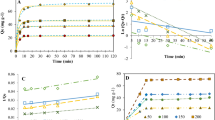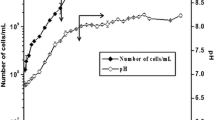Abstract
The ability of live cells (LC), freeze dried cells (FDC) and oven dried cells (ODC) of the yeast Rhodotorula glutinis to remove lead from aqueous solution has been studied. Discernible differences were found between the biosorption properties of LC and the other two types of cell preparation. The LC preparation exhibited an uptake level of about 12 mg g−1 in a batch contactor with a biomass dosage of 2 g l−1 and an initial lead concentration of 100 mg l−1. This compared with, respectively, about 26 and 30 mg g−1 for the FDC and ODC biosorbents under the same experimental conditions. It is seen that the level of lead uptake by the two latter biosorbents was increased to, respectively, 2.2- and 2.5-fold of the level observed for the LC preparation. The superior performance of the FDC and ODC biosorbents in the lead binding process was attributed to the presence of additional binding sites on their cell wall surfaces as indicated by potentiometric titration data. These binding sites were ascribed to carboxylic and phosphoric groups, which are the primary sites of divalent metal complexation. Modeling of the titration data revealed that subjecting R. glutinis biomass to freeze drying or oven drying increased its proton binding site concentration by a factor of 3. It appears that the two simple physical treatments were able to compromise the R. glutinis cell wall structure in such a way as to make sites normally inaccessible to become active in proton and lead binding.




Similar content being viewed by others
References
Bahmed K, Quilès F, Bonaly R, Coulon J (2003) Fluorescence and infrared spectrometric study of cell walls from Candida, Kluyveromyces, Rhodotorula and Schizosaccharomyces yeasts in relation with their chemical composition. Biomacromolecules 4:1763–1772
Berthe MC, Charpentier C, Lenatre J, Bonaly R (1981) Glucosamine and chitin accumulation in cell walls of the yeast Rhodotorula glutinis CBS 3044. Influence of culture conditions. Biochem Biophys Res Commun 100:1504–1514
Bohart GS, Adams EQ (1920) Some aspects of the behavior of charcoal with respect to chlorine. J Am Chem Soc 42:523–529
Borrok DM, Fein JB (2005) The impact of ionic strength on the adsorption of protons, Pb, Cd, and Sr onto the surfaces of Gram negative bacteria: testing non-electrostatic, diffuse, and triple-layer models. J Colloid Interface Sci 286:110–126
Brassard P, Kramer JR, Collins PV (1990) Binding sites analysis using linear programming. Environ Sci Technol 24:195–201
Cho DH, Kim EY (2003) Characterization of Pb2+ biosorption from aqueous solution by Rhodotorula glutinis. Bioprocess Biosyst Eng 25:271–277
Cho DH, Chae HJ, Kim EY (2001) Synthesis and characterization of a novel extracellular polysaccharide from Rhodotorula glutinis. Appl Biochem Biotechnol 95:183–193
Cho DH, Yoo MH, Kim EY (2004) Biosorption of lead (Pb2+) from aqueous solution by Rhodotorula aurantiaca. J Microbiol Biotechnol 14:250–255
Chojnacka K (2010) Biosorption and bioaccumulation—the prospects for practical applications. Environ Int 36:299–307
Cox JS, Smith DS, Warren LA, Ferris FG (1999) Characterizing heterogeneous bacterial surface functional groups using discrete affinity spectra for proton binding. Environ Sci Technol 33:4514–4521
Fein JB (2006) Thermodynamic modeling of metal adsorption onto bacterial cell walls: current challenges. In: Sparks DL (ed) Advances in agronomy, vol 90. Academic Press/Elsevier, San Diego, pp 179–202
Gomes NCM, Rosa CA, Pimentel PF, Mendonça-Hagler LCS (2002) Uptake of free and complexed silver ions by different strains of Rhodotorula mucilaginosa. Braz J Microbiol 33:62–66
Li Z, Yuan H (2006) Characterization of cadmium removal by Rhodotorula sp. Y11. Appl Microbiol Biotechnol 73:458–463
Li Z, Yuan H (2008) Responses of Rhodotorula sp. Y11 to cadmium. Biometals 21:613–621
Li Z, Yuan H, Hu X (2008) Cadmium-resistance in growing Rhodotorula sp. Y11. Bioresour Technol 99:1339–1344
Liu H, Fang HHP (2002) Characterization of electrostatic binding sites of extracellular polymers by linear programming analysis of titration data. Biotechnol Bioeng 80:806–811
Loebenstein WV (1962) Batch adsorption from solution. J Res Natl Bur Stand A Phys Chem 66A:503–515
Machado MD, Janssens S, Soares HMVM, Soares EV (2009) Removal of heavy metals using a brewer’s yeast strain of Saccharomyces cerevisiae: advantages of using dead biomass. J Appl Microbiol 106:1792–1804
Naeem A, Woertz JR, Fein JB (2006) Experimental measurement of proton, Cd, Pb, Sr, and Zn adsorption onto the fungal species Saccharomyces cerevisiae. Environ Sci Technol 40:5724–5729
Naja G, Mustin C, Volesky B, Berthelin J (2005a) A high-resolution titrator: a new approach to studying binding sites of microbial biosorbents. Water Res 39:579–588
Naja G, Mustin C, Volesky B, Berthelin J (2005b) Lead biosorption study with Rhizopus arrhizus using a metal-based titration technique. J Colloid Interface Sci 292:537–543
Naja G, Mustin C, Volesky B, Berthelin J (2006) Association constants of Pb2+ with binding sites of fungal biomass using metal-based titrations. Environ Technol 27:109–117
Nguyen VAT, Senoo K, Michima T, Hisamatsu M (2001) Multiple tolerance of Rhodotorula glutinis R-1 to acid, aluminum ion and manganese ion, and its unusual ability of neutralizing acidic medium. J Biosci Bioeng 92:366–371
Salinas E, Elorza de Orellano M, Rezza I, Martinez L, Marchesvky E, Sanz de Tosetti M (2000) Removal of cadmium and lead from dilute aqueous solutions by Rhodotorula rubra. Bioresour Technol 72:107–112
Strandberg GW, Shumate SE II, Parrot JR Jr (1981) Microbial cells as biosorbents for heavy metals: accumulation of uranium by Saccharomyces cerevisiae and Pseudomonas aeruginosa. Appl Environ Microbiol 41:237–245
Zhang Y, Liu W, Xu M, Zheng F, Zhao M (2010) Study of the mechanisms of Cu2+ biosorption by ethanol/caustic-pretreated baker’s yeast biomass. J Hazard Mater 178:1085–1093
Conflict of interest
The authors have declared no conflict of interest.
Author information
Authors and Affiliations
Corresponding author
Rights and permissions
About this article
Cite this article
Cho, D.H., Chu, K.H. & Kim, E.Y. Lead uptake and potentiometric titration studies with live and dried cells of Rhodotorula glutinis . World J Microbiol Biotechnol 27, 1911–1917 (2011). https://doi.org/10.1007/s11274-011-0652-3
Received:
Accepted:
Published:
Issue Date:
DOI: https://doi.org/10.1007/s11274-011-0652-3




